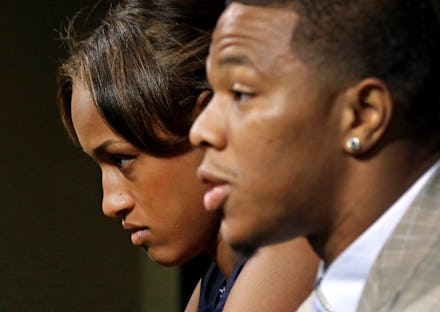7 Truths About Domestic Violence You'll Never Learn From Watching a TMZ Video

It took them seven months, but: The Baltimore Ravens have terminated Ray Rice's contract.
The decision came on Monday when TMZ released a video of the 27-year-old running back punching his then-fiancée Janay Palmer in the face and dragging her unconscious body from an elevator.
Rice certainly had it coming. But make no mistake: His firing was little more than a financially motivated attempt to save face once the incident's backlash threatened the organization's bottom line.
Plus the Ravens had already botched their initial response in May with this tone-deaf, victim-blaming disaster of a tweet:
(Note: Mother Jones reports the Ravens deleted the tweet today, three months after posting it.)
So while the team may have finally — and grudgingly — done the right thing, this is hardly the time for self-congratulations.
There's a larger problem to address: It hides beneath the surface of the TMZ-leaked video and the corporate tap dance surrounding it.
Specifically, most domestic violence, especially against black women, lacks the high profile and galvanizing visual element of Rice's attack on Palmer. It doesn't appear on camera. It's rarely subject to intense public scrutiny and debate. And perpetrators are typically not punished in any conscionable way for their brutality.
In fact: Most domestic violence remains largely hidden outside the relationships in which it occurs.
Which is why these seven facts about domestic violence against black women — courtesy of the National Coalition Against Domestic Violence (NCADV) and the University of Minnesota's Institute on Domestic Violence in the African American Community (IDVAAC) — are so important to recognize as this situation unfolds:
1. Domestic violence is one of the most "chronically underreported" crimes in America.
According to the NCADV, about 75% of physical violence against women committed by an intimate partner goes unreported to the police. Rice's assault on Palmer was an outlier, largely because it was caught on camera.
2. For many women, domestic abuse leads to death.
This is notably true for black women, who comprised 8% of the U.S. population but 22% of intimate partner homicide victims and 29% of all female victims of intimate partner homicide in 2005.
Needless to say, these figures are remarkably disproportionate. Janay Palmer is not alone in her circumstances.
3. About 50% are killed while trying to leave their abuser.
IDVAAC writes, "Among African American women killed by their partner, almost half were killed while in the process of leaving the relationship, highlighting the need to take extra precautions at that time."
This is an important figure for anyone claiming Palmer should've simply left Rice after he punched her.
It's the same type of victim-blaming that permeated ESPN's disgusting coverage of the NFL's two-game suspension of Rice, which they inexplicably framed as adequate "punishment" for a man who could've easily killed a woman.
Leaving is rarely that simple, and is often extremely dangerous.
4. Yet in spite of the danger, most try anyway.
Between 70% and 80% of abused black women leave or try to leave their abusive relationship, according to IDVAAC.
In any case, criticizing a woman's reaction — chosen or otherwise — to being abused shows either a deep lack of compassion toward what she's enduring, or a severe misunderstanding of the very real danger she may face in doing so.
5. The cost of domestic violence goes far beyond bruises.
Black women who are battered are at greater risk for the following than their counterparts who aren't abused: Physical ailments, mental health issues, suicide, lowered likelihood of practicing safe sex and greater likelihood of substance abuse during pregnancy.
In addition, the cost of direct medical and mental health services linked to domestic violence is $4.1 billion a year, according to NCADV.
6. Risk factors for domestic violence are usually socioeconomic.
This is not to suggest that domestic abuse is the exclusive purview of low-income blacks. Just ask Ray Rice, who made $25 million in salary from the Ravens over the past two seasons.
Nevertheless, intimate partner violence among black Americans happens most often among low-income couples, those who live in poor neighborhoods or in cases where the male partner is unemployed or underemployed, according to IDVAAC.
Tellingly, the racial gap in domestic violence numbers — which currently favors blacks — narrows significantly once factors like income and neighborhood are accounted for.
7. There is hope.
Black women who'd been abused but "reported that they could rely on others for emotional and practical support" were less likely to be abused again, and less likely to attempt suicide, according to the IDVAAC.
This fact highlights the incredible importance of being an ally to friends, family and others who are victims of abuse, and of seeking support when victimized yourself. Doing so could mean the difference between life and death.
The takeaway: The distinct tenor of domestic violence against black women also fits into a larger culture of misogyny that targets all women, with the looming threat of physical violence — even death — a frighteningly common characteristic.
Ray Rice is not the first man to beat his girlfriend. But due to his fame, his reprehensible actions are a telling microcosm of what countless women cope with in obscurity every day.
h/t The Grio